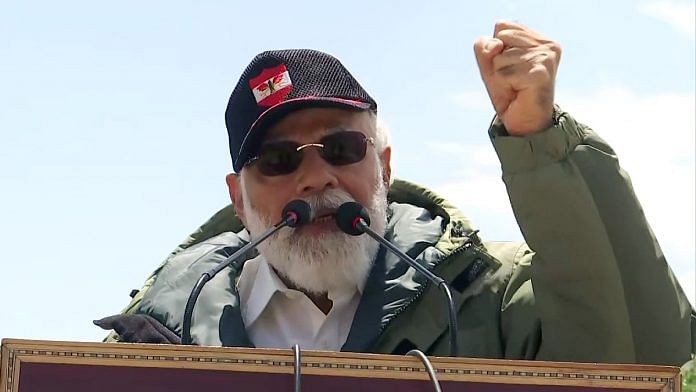New Delhi: Prime Minister Narendra Modi, who made a surprise visit to Ladakh Friday, said India’s enemies have seen her “fire and fury” in a nod to the Leh-based 14 Corps while addressing soldiers. The 14 Corps is also known as the Fire and Fury Corps.
During his visit, the prime minister was seen wearing a cap with the 14 Corps insignia embossed on it. The insignia comprises two crossed flaming thunderbolts (Vajra) with a sword in between. 14 Corps is the only corps in the Indian Army that faces both Pakistan and China. The world’s highest battlefield Siachen falls under the purview of the 14 Corps.
Modi’s visit, along with the Chief of Defence Staff General Bipin Rawat and Army Chief General M.M. Naravane, comes at a time India has been locked in a stand-off with China for two months at the Line of Actual Control in Eastern Ladakh. Last month, on 15 June, tensions spiked following a violent face-off between troops, leading to 20 Indian soldiers being killed in action.
In his speech, Modi said the age of expansionism is over and this is the age of development.
“History is witness that expansionist forces have either lost or were forced to turn back,” he said.
Also read: PM Modi sends message to China from Ladakh: ‘Age of expansionism is over’
‘Fire and Fury’ Corps
The Vajra is an important symbol in both Hindu and Buddhist philosophy and denotes strength and victory. The insignia as such holds no religious significance.
A senior Army officer told ThePrint that the insignia symbolises power and valour to the them.
“The thunderbolts and the sword also depict fury and success,” the officer said, emphasising the formation was raised soon after the Kargil conflict on 1 September 1999.
Talking to ThePrint, retired Brigadier R.K. Kohli said the emblem signifies an offensive or a strike symbol.
“It was the most appealing at that time for the formation,” said Kohli, who had served in Ladakh when the 14 Corps was raised.
“At that time, we had asked people to give suggestions and it was the most appropriate one chosen, considering what is required of the formation at that time, in view of what had transpired in the recent past,” he said.
Also read: Modi govt needs to come clean on China. India must win information wars too
Visiting dignitaries are given a cap
The Army officer quoted above explained that each formation in the Army has troops of all arms and services, and has its respective caps and distinctive cap badges.
“Each formation has made its separate cap with its own insignia, which is worn by all ranks irrespective of the arm or service. While this is an informal cap, and worn largely out of uniform, it identifies with the formation,” the officer explained.
Such caps are also presented to visiting dignitaries, who wear them while interacting with the troops to identify with them.
Also read: India, China repeat calls for phased de-escalation in 3rd round of corps commander talks






